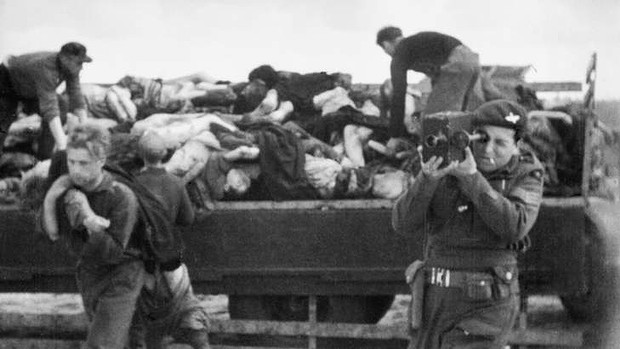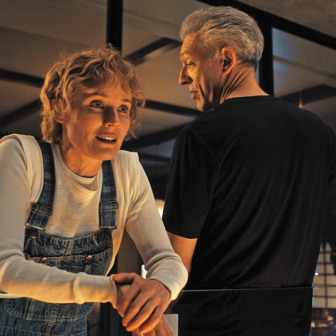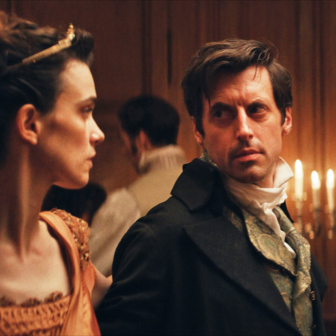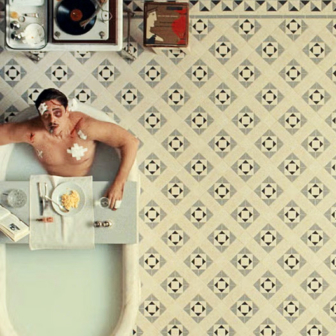The demanding documentary event named German Concentration Camps Factual Survey, shown last October at the Melbourne International Film Festival and later at two crowded special screenings in Sydney, has now had exactly one screening at the National Film and Sound Archive in Canberra, and will not be travelling elsewhere. That’s a pity, both for our grasp of wartime history and for our knowledge of the complicated relations of history and film.
This work is largely composed of footage shot by British, American and Russian cameramen when, in the spring of 1945, the Allied forces opened the camps, confronted the full horrors and scale of the Nazi atrocities, organised the mass burials, and freed and fed the survivors. Sidney Bernstein, of the British Ministry of Information, directed the initial assemblage of the film, taking in material shot at several sites of liberation. He brought in two expert film advisers, Alfred Hitchcock and later, Billy Wilder; one consequence of that move was that Hitchcock was wrongly believed to have been the director. In fact he advised on the developing project for only a month, and the correct credit made him a “treatment adviser”; but if you want to find one Hitchcockian touch, it is surely there in the shift from images of ostensibly innocent, prosperous rural life to the camp at Bergen-Belsen.
Later, Auschwitz and the other camps are seen more briefly, with the huge piles of shoes without owners, the spectacles, the stacks of human hair. A Christian burial ritual is briefly seen as the bulldozers shift the mountain of emaciated corpses; and the commentary notes that no one knows who were Catholics, Lutherans or Jews. That, in later responses, becomes an interesting disavowal; there is the implication that this wasn’t all about the Final Solution. The initial intention of German Concentration Camps Factual Survey was to expose, as widely as possible, the realities of the camps and to bring them home to the German people; and the film says aloud that no German could have been ignorant of what was happening in Belsen, Mauthausen, Auschwitz and the rest: we look at the maps.
In the space of a year, that aim changed with a shift in the ruling policy. Retribution gave way to reconstruction, and there were early intimations of the cold war. For the Western Allies, this meant it was time to begin making friends with Germany, devastated as that country was, and notwithstanding everything that could be said about collective guilt. For those reasons, the film remained for decades in London’s Imperial War Museum, unfinished. There were five reels to be edited, a shot list and typewritten commentary. A sixth reel was missing; this has been put together from unedited footage and the shot list, with commentary re-recorded and spoken now by Jasper Britton. The present version had its premiere at the Berlinale of February 2014; and for audiences there the appearance of the film might have helped them forward in dealing with what many writers and film-makers have called “the unmastered past.”
Viewers here and now include elderly survivors of the camps, and people who were born to survivors; some of these find the film unwatchable, while others – seemingly anaesthetised – appear to welcome this wider circulation of the truth. There are those who observe that while we are shown the gas ovens, with company names in evidence, we should be told more of the complicity of Krupp, Volkswagen and their like. And there are others in Australian audiences, generally the young, who rise during the Q&A after the screening to remind us that the Australian viewing position is not an innocent one. This country too builds inhuman barracks; this country too has been merciless. Older voices then come in to say there’s no comparison; but the critical point has to do, not with comparisons, but with the ethics of viewing: knowing where you sit while you watch.
The limited presentations of this film, restricted as they have been, are the kind of work the National Film and Sound Archive should always be engaged in through its public programs. While the NFSA contends with increased budgetary limitations, those programs must not be given up. I will write more before long on the present and future of this institution, in an Australia now governed by rulers who would rather we didn’t think, least of all on film.
On the second world war and the camps, there’s a much better film to look at: Alain Resnais’s Nuit et Brouillard (Night and Fog, 1955). (It is retrievable, and the whole work can be viewed, inadequately, on YouTube.) Only ten years after the liberation, Resnais made this thirty-two-minute essay on the sites of Auschwitz and other abandoned camps, with commentary by the survivor Jean Cayrol; Chris Marker, uncredited, assisted with both script and direction. Green fields are visible through barbed wire, then in black and white, stills and moving film from the archive, we can see the abandoned barracks, the boxcars, the rail tracks, and see the German soldiers marching in order. The film owes some of its life to the way the Nazis, compulsively, filmed everything they did, including the extreme wretchedness of their victims. Their film archive outlasted their rule; they left the materials for their own condemnation.
The words of the narration run across the images, with Hanns Eisler’s music. They are concerned less with memory and history than with addressing the viewers of the future, and the way these sites will be seen: “Nine million dead haunt this countryside… We pretend to be hopeful again, that all this is going back into the past… We pretend that it could only happen once, in this place at that time… The icy water fills the hollows of the mass graves, while War goes to sleep, but with one eye always open.”
When the film-maker and artist David Perry died in Sydney two weeks ago, another link was broken with the creative upsurge of the later sixties in that city, when it seemed that there was another poetic, exciting no-budget film essay on show every week in basements, university spaces and ramshackle group houses. David, with his friend the late Albie Thoms, was one of the principal moving spirits in Ubu Films, named for Alfred Jarry’s Ubu Roi; a group of filmers (his word) who didn’t believe in budgets or scripts or in those toilsome processes known as pre-production and script development; they believed in free-ranging camerawork, and indeed films made without cameras – scratched, painted, drawn, dyed; in the tribal friendship network, and imagination. The output was funny, ribald, subversive; sometimes you could call it juvenile, but a lot of it – by Albie, David, Garry Shead, Clemency Weight, and many others – still glows and dances.
The films were of course about sex; once about defecation (It Droppeth as the Gentle Rain); about pregnancy (A Sketch on Abigayl’s Belly); about seeing (Bolero); about art and modernism (Thoms’s Marinetti). Sometimes, in registrations of anti–Vietnam war rallies, they were even about politics. What they were notionally about, however, mattered less than what they were: serious, insubordinate fun with the basic resources of cinema, exploring, playing with style, technique and then-new technologies, especially video. (This essential, but under-recognised cultural history is explored very fully in Peter Mudie’s superbly documented work, Ubu Films: Sydney Underground Movies, published in 1997 by UNSW Press with the Australian Film Commission.)
Ubu metamorphosed into the Sydney Filmmakers Co-operative, Ubu News into the remarkable monthly Filmnews. The notion of “experimental film” faded; some of Ubu’s membership joined the nascent mainstream industry, some as mainstream commercial producers, some to make costume dramas in depressingly good taste (Picnic at Hanging Rock, and all its conformist ilk) and then head off to Hollywood. Others carried on, making and screening whatever could be made, sustaining inventive low-budget film-work and a healthy suspicion of the industry.
Of those, David Perry, working for TV here and in Britain, teaching inspiringly, remained perennially engaged in small-scale production and in communicating its pleasures. He remained cheerfully and generously “a dedicated amateur” – his phrase – and until his last illness he was looking, painting, drawing, thinking. His splendid feature, The Refracting Glasses, registered his passions in modernism, especially the inheritance from the Russian Constructivists, brought that inheritance back to life – and linked it all, furthermore, to local adventures and the tale of Ern Malley. This film, the first for which David had substantial funding, had a premiere at the Sydney Film Festival of 1992, then a poorly attended one-week season at the Chauvel; there, David wrote, “it sank like a modernist stone in a post-modernist ocean.” It’s the only film I know – there may be others – that imagines again the never-built Tatlin Monument, that helical structure to be built for the Third International; a building meant to be taller than the Eiffel Tower, and composed, as they said, “of steel, glass and revolution.”
David left us his lively recollections in Memoirs of a Dedicated Amateur (Valentine Press, 2014). He was given a great send-off; The Refracting Glasses was played through at the funeral, as was his 1970 compilation, Album. He was eighty-one, almost eighty-two when he died; but David never stopped being young, and his output is testament to the gifts of a long-sustained youthfulness of heart.





